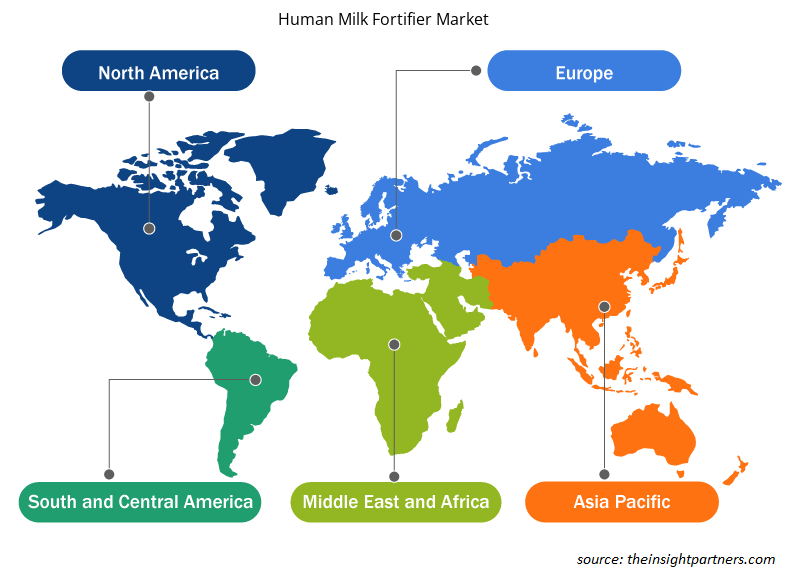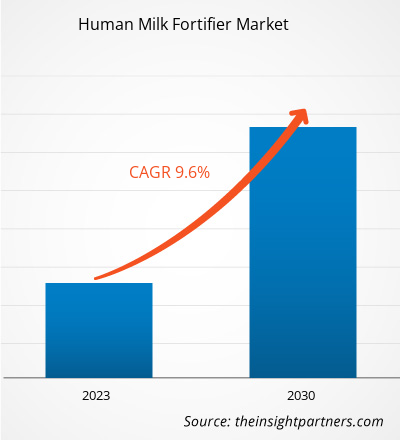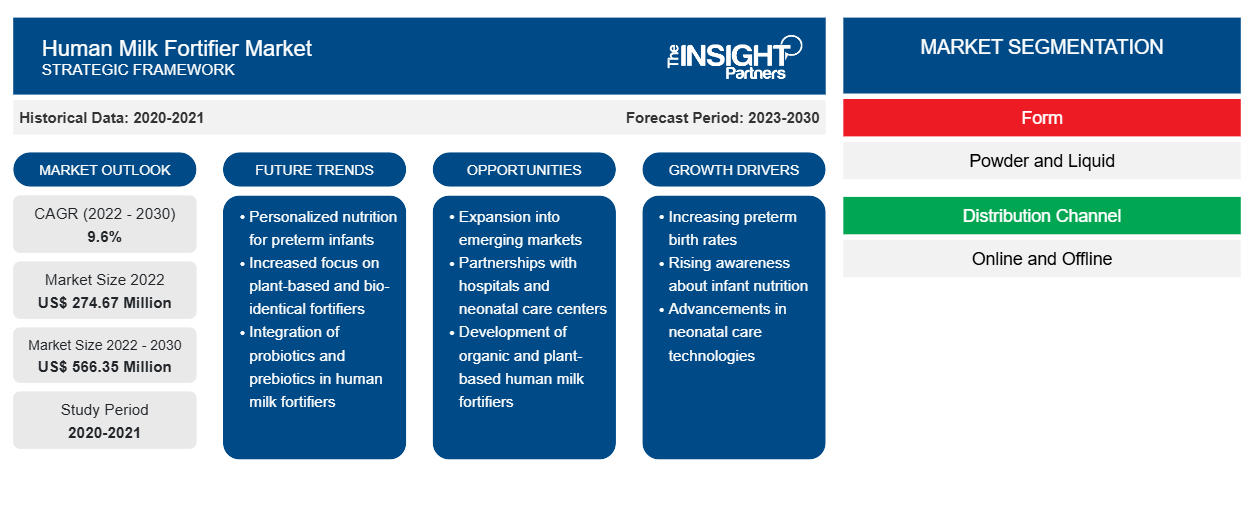[Rapport de recherche] La taille du marché des fortifiants pour lait maternel devrait passer de 274,67 millions USD en 2022 à 566,35 millions USD d'ici 2030 ; elle devrait enregistrer un TCAC de 9,6 % de 2023 à 2030.
Informations sur le marché et point de vue des analystes :
Les fortifiants pour lait maternel sont des compléments nutritionnels ajoutés au lait maternel pour fournir des calories, des électrolytes et des vitamines supplémentaires aux nourrissons. Ils sont généralement prescrits aux bébés prématurés dans l'unité de soins intensifs néonatals (USIN) pour assurer l'apport nutritionnel et améliorer le développement et la croissance globale. En outre, les bébés de faible poids se voient également prescrire des fortifiants pour lait maternel.
Moteurs de croissance et défis :
Ces dernières années, le nombre de naissances prématurées a augmenté en raison de l'évolution des modes de vie et des maladies chroniques telles que le diabète et l'hypertension artérielle. Selon les Centers for Disease Control and Prevention (CDC), en 2021, la naissance prématurée a touché environ 1 nourrisson sur dix né aux États-Unis. Le taux de naissance prématurée aux États-Unis est passé de 10,1 % en 2020 à 10,5 % en 2021. L'Organisation mondiale de la santé (OMS) a estimé qu'environ 13,4 millions de bébés sont nés en 2020. La complication de la naissance prématurée est la principale cause de décès chez les enfants de moins de cinq ans, responsable d'environ 900 000 décès en 2019. Les bébés prématurés peuvent avoir des problèmes respiratoires, des difficultés d'alimentation, des retards de développement, une paralysie cérébrale et des problèmes de vision et d'audition.
Le nombre croissant de naissances prématurées a fait grimper la demande de fortifiants pour le lait maternel pour la croissance et le développement appropriés des nourrissons. De nombreux nourrissons prématurés ont besoin de nutriments supplémentaires ajoutés au lait maternel. Ils ont souvent besoin de protéines, de calcium, de phosphore et de sel supplémentaires pour développer des os solides et des organes sains. Les fortifiants pour lait maternel aident à fournir ces nutriments supplémentaires aux nourrissons. Dans les fortifiants pour lait maternel, des nutriments supplémentaires sont ajoutés au lait avant qu'il ne soit donné aux bébés. Ainsi, une augmentation des naissances prématurées renforce la croissance du marché des fortifiants pour lait maternel .
Les gouvernements ont imposé diverses règles et réglementations liées à la fabrication et à l'utilisation des fortifiants pour lait maternel afin d'assurer la sécurité des nouveau-nés et de maintenir les normes de qualité du produit. Au Canada, les fortifiants pour lait maternel sont réglementés par le Règlement sur les aliments et drogues (RAD). La règle de la partie B, division 25 (B.25.019) du RAD est mise en œuvre pour assurer la vente appropriée des fortifiants pour lait maternel sous une supervision médicale appropriée. De plus, le fortifiant pour lait maternel doit fournir à Santé Canada une soumission préalable à la mise en marché. L'article B.25.011, paragraphes (a) à (n), précise les exigences réglementaires pour un nouveau fortifiant pour lait maternel. Aux États-Unis, le fortifiant pour lait maternel est classé comme une préparation pour nourrissons exemptée; cependant, les fabricants doivent satisfaire aux exigences de la Food and Drug Administration (FDA) des États-Unis, qui garantit la déclaration des éléments nutritifs, y compris la quantité de chaque minéral et vitamine énumérés dans les annexes du produit. La mise en œuvre de ces réglementations a entravé la fabrication de fortifiants pour lait maternel, limitant ainsi la croissance du marché.
Personnalisez ce rapport en fonction de vos besoins
Vous bénéficierez d'une personnalisation gratuite de n'importe quel rapport, y compris de certaines parties de ce rapport, d'une analyse au niveau des pays, d'un pack de données Excel, ainsi que de superbes offres et réductions pour les start-ups et les universités.
-
Obtenez les principales tendances clés du marché de ce rapport.Cet échantillon GRATUIT comprendra une analyse de données, allant des tendances du marché aux estimations et prévisions.
Segmentation et portée du rapport :
Le marché mondial des fortifiants pour lait maternel est segmenté en fonction de la forme, du canal de distribution et de la géographie. Le marché des fortifiants pour lait maternel est segmenté en poudre et en liquide en fonction de la forme. Le marché des fortifiants pour lait maternel est classé en ligne et hors ligne en fonction des canaux de distribution. Le marché mondial des fortifiants pour lait maternel est largement segmenté par géographie en Amérique du Nord, Europe, Asie-Pacifique, Moyen-Orient et Afrique, et Amérique du Sud et Amérique centrale.
Analyse segmentaire :
En fonction de la forme, le marché des fortifiants pour lait maternel est segmenté en poudre et en liquide. Le segment de la poudre devrait enregistrer un TCAC plus élevé au cours de la période de prévision. Les fortifiants pour lait maternel sous forme de poudre complètent et améliorent la teneur nutritionnelle du lait maternel. Le lait maternel fortifié est prescrit aux nourrissons prématurés ou médicalement fragiles. Les gens préfèrent les fortifiants pour lait maternel en poudre pour leur commodité de stockage, de manipulation et de préparation. De plus, ils sont plus faciles à stocker et à transporter tout en garantissant une durée de conservation plus longue que les produits liquides.
En fonction du canal de distribution, le marché des fortifiants pour lait maternel est classé en ligne et hors ligne. Le segment en ligne devrait enregistrer un TCAC plus élevé au cours de la période de prévision. Les magasins de détail en ligne sont associés à la commodité de faire des achats dans le confort de son domicile. Les parents peuvent parcourir et acheter des fortifiants pour lait maternel à tout moment qui leur convient sans se rendre dans un magasin. De plus, les plateformes en ligne leur donnent souvent accès à une large gamme de fortifiants, ce qui permet aux parents d'explorer diverses options et de choisir le produit le plus adapté. De plus, les fortifiants pour lait maternel peuvent ne pas être disponibles dans les magasins locaux ou spécialisés ; les magasins en ligne donnent accès à un inventaire plus étendu, ce qui permet aux consommateurs de trouver plus facilement des marques spécifiques non disponibles dans leur localité. Les avis des clients et les informations détaillées sur les produits aident également les parents à prendre des décisions plus éclairées. En lisant les avis d'autres parents qui ont utilisé le produit, ils peuvent avoir un aperçu de son efficacité et de son adéquation. Les détaillants en ligne proposent souvent des prix compétitifs en raison de frais généraux inférieurs à ceux des magasins physiques. Cela peut profiter aux utilisateurs à la recherche d'options économiques ou à la comparaison des prix entre différents vendeurs. De plus, certains utilisateurs préfèrent acheter discrètement des fortifiants pour lait maternel, car ils sont sensibles au fait de discuter publiquement de la santé de leur bébé. Les canaux en ligne offrent une confidentialité et permettent un achat et une livraison discrets.
Analyse régionale :
Français Sur la base de la géographie, le marché de la farine de riz est divisé en cinq régions clés : Amérique du Nord, Europe, Asie-Pacifique, Amérique du Sud et centrale, et Moyen-Orient et Afrique. Le marché en Amérique du Nord était évalué à environ 85,82 millions de dollars américains en 2022. L'Asie-Pacifique devrait enregistrer un TCAC d'environ 10,4 % au cours de la période de prévision. À mesure que les niveaux de revenu disponible augmentent en Asie-Pacifique, davantage de parents peuvent se permettre des produits de santé haut de gamme, notamment des fortifiants pour lait maternel. Cela a contribué à la croissance du marché, car les parents sont prêts à investir dans des produits qui peuvent améliorer la santé et le bien-être de leur enfant. De plus, l'expansion des infrastructures de soins de santé, y compris les unités de soins intensifs néonatals (USIN), dans toute l'Asie-Pacifique a créé un environnement favorable à la croissance du marché des fortifiants pour lait maternel. Les hôpitaux et les établissements de santé sont mieux équipés pour fournir des soins spécialisés aux nourrissons prématurés, ce qui augmente la demande de fortifiants pour lait maternel.
Aperçu régional du marché des fortifiants pour lait maternel
Les tendances régionales et les facteurs influençant le marché des fortifiants au lait maternel tout au long de la période de prévision ont été expliqués en détail par les analystes d’Insight Partners. Cette section traite également des segments et de la géographie du marché des fortifiants au lait maternel en Amérique du Nord, en Europe, en Asie-Pacifique, au Moyen-Orient et en Afrique, ainsi qu’en Amérique du Sud et en Amérique centrale.

- Obtenez les données régionales spécifiques au marché des fortifiants pour le lait maternel
Portée du rapport sur le marché des fortifiants pour le lait humain
| Attribut de rapport | Détails |
|---|---|
| Taille du marché en 2022 | 274,67 millions de dollars américains |
| Taille du marché d'ici 2030 | 566,35 millions de dollars américains |
| Taux de croissance annuel moyen mondial (2022-2030)CAGR (2022 - 2030) | 9,6% |
| Données historiques | 2020-2021 |
| Période de prévision | 2023-2030 |
| Segments couverts |
Par formulaire
|
| Régions et pays couverts |
Amérique du Nord
|
| Leaders du marché et profils d'entreprises clés |
|
Densité des acteurs du marché des fortifiants pour lait maternel : comprendre son impact sur la dynamique commerciale
Le marché des fortifiants pour lait maternel connaît une croissance rapide, tirée par la demande croissante des utilisateurs finaux en raison de facteurs tels que l'évolution des préférences des consommateurs, les avancées technologiques et une plus grande sensibilisation aux avantages du produit. À mesure que la demande augmente, les entreprises élargissent leurs offres, innovent pour répondre aux besoins des consommateurs et capitalisent sur les tendances émergentes, ce qui alimente davantage la croissance du marché.
La densité des acteurs du marché fait référence à la répartition des entreprises ou des sociétés opérant sur un marché ou un secteur particulier. Elle indique le nombre de concurrents (acteurs du marché) présents sur un marché donné par rapport à sa taille ou à sa valeur marchande totale.
Les principales entreprises opérant sur le marché des fortifiants pour lait maternel sont :
- Laboratoires Abbott
- NeoLacta Lifesciences Pvt Ltd
- Nestlé SA
- Prolacta Bioscience Inc
- Lead Care International Ltd
Avis de non-responsabilité : les sociétés répertoriées ci-dessus ne sont pas classées dans un ordre particulier.

- Obtenez un aperçu des principaux acteurs clés du marché des fortifiants pour lait maternel
Développements de l'industrie et opportunités futures :
Diverses initiatives prises par les principaux acteurs opérant sur le marché des fortifiants pour lait maternel sont énumérées ci-dessous :
- En janvier 2022, Prolacta Bioscience a lancé des fortifiants pour lait maternel au Japon. Ce lancement visait à pénétrer le marché inexploité du pays et à contribuer à améliorer la santé des nouveau-nés. En novembre 2020, Lifeblood Milk et le South Australian Health and Medical Research Institute (SAHMRI) ont conclu un partenariat avec le CSIRO, l'agence scientifique nationale australienne. Le partenariat visait à développer des fortifiants pour lait maternel afin d'améliorer la nutrition et la croissance des bébés prématurés.
- En septembre 2021, Neolacta Lifesciences Pvt. Ltd a lancé ses produits sur des plateformes de commerce électronique pour garantir une disponibilité facile de ses produits tels que le lait maternel humain Neolacta et le Neolacta MMF (Mother's Milk Fortifier) pour les parents.
Impact du Covid-19 :
La pandémie de COVID-19 a initialement affecté le marché mondial des fortifiants pour lait maternel en raison de la fermeture des unités de fabrication, de la pénurie de main-d'œuvre, de la perturbation des chaînes d'approvisionnement et de l'instabilité financière. La perturbation de diverses industries due au ralentissement économique provoqué par l'épidémie de COVID-19 a limité la demande de fortifiants pour lait maternel. Cependant, les entreprises gagnent du terrain car les restrictions précédemment imposées ont été assouplies dans divers pays. De plus, l'introduction de vaccins contre la COVID-19 par les gouvernements de différents pays a amélioré la situation, entraînant une augmentation des activités commerciales dans le monde entier. Plusieurs marchés, dont le marché des fortifiants pour lait maternel, ont connu une croissance après l'assouplissement des mesures de confinement et des restrictions de mouvement.
Paysage concurrentiel et entreprises clés :
Certains des principaux acteurs opérant sur le marché mondial des fortifiants pour lait maternel comprennent Abbott Laboratories, NeoLacta Lifesciences Pvt Ltd, Nestle SA, Prolacta Bioscience Inc, Lead Care International Ltd, Raptakos, Brett & Co Ltd, NeoKare Nutrition Ltd, Danone SA, Neolac Inc et Reckitt Benckiser Group Plc.
- Analyse historique (2 ans), année de base, prévision (7 ans) avec TCAC
- Analyse PEST et SWOT
- Taille du marché Valeur / Volume - Mondial, Régional, Pays
- Industrie et paysage concurrentiel
- Ensemble de données Excel
Rapports récents
Rapports connexes
Témoignages
Raison d'acheter
- Prise de décision éclairée
- Compréhension de la dynamique du marché
- Analyse concurrentielle
- Connaissances clients
- Prévisions de marché
- Atténuation des risques
- Planification stratégique
- Justification des investissements
- Identification des marchés émergents
- Amélioration des stratégies marketing
- Amélioration de l'efficacité opérationnelle
- Alignement sur les tendances réglementaires























 Obtenez un échantillon gratuit pour - Marché des fortifiants pour lait maternel
Obtenez un échantillon gratuit pour - Marché des fortifiants pour lait maternel